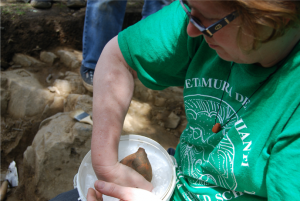Since 2010, UNC Asheville Classics Professor and Chair Lora Holland Goldthwaite has been spending her summers among Italian antiquities in an idyllic hillside town in Tuscany.
She is part of a team that has been working on an archeological dig site at Cetamura del Chianti, and for the past six years, her focus has been on researching and cataloging an extraordinary hoard of Roman coins. Organized by Florida State University, and joined by UNC Asheville’s Archaeological Field School for students, the Cetamura del Chianti has been an active site for discovering artifacts of Etruscans, Romans, and Italians of the Middle Ages since the 1970s.
For over 40 years, a team of archeologists and professors have worked alongside visiting students at the Cetamura del Chianti, revealing and documenting artifacts that depicted daily life from ancient Italian cultures. Discoveries across the site have ranged from statues, scattered coins, and objects of bronze, silver, and wood to organic remains like grape seeds.
But then in 2015, an astounding discovery was made. The team had discovered the top of an upside-down vessel lodged next to a wall of bedrock and packed under thousands of years of built-up soil. What would eventually be revealed was a hoard of Roman coins dating back from ca.169 BCE to ca. 27 BCE.
“The area where we were digging had been under investigation for several years,” recalls Holland Goldthwaite. Finds in that spot had consisted “mostly of pieces of tile and pottery, animal bones, fragments of ancient oil lamps, and slag from metal-working. Very few coins, [except for] isolated finds in poor condition, had ever been found in that area of the dig. We were not expecting to find a small pottery jar filled with coins in that area.”
Laurel Taylor, senior lecturer in the Departments of Art and Art History and of Classics, was also working at Cetamura del Chianti that summer and recalls, ‘“during the course of the excavation day an unusual ceramic globular jar appeared seemingly wedged upside-down intentionally in a rock crevice. Because the jar was also very well preserved, it was immediately apparent that its burial was deliberate.”
Due to the extraordinary nature of the object, the team slowed down the excavation process taking time to photograph, draw, and piece-plot the area. When the vessel was ultimately extracted, the team, led by Dr. Nancy de Grummond, found that it was packed full of dirt, but too heavy to contain only sediment. The vessel was sent to Florence to be conserved and examined, and after several months, the coins were found. Inside were 194 coins that included the faces of Octavian, the future Augustus, of his enemy Marcus Anthony and Cleopatra.

“I was able to identify most of the coins as they were extracted and displayed beneath a digital microscope,” remarked Holland Goldthwaite. Through Skype, the coins were presented to Holland Goldthwaite, “but a few were too corroded to identify after being buried for approximately 2,040 years. After the corrosion was removed by our conservator, we were able to identify all the coins.”
Holland Goldthwaite’s expertise led her to become an integral member of the exhibition team for the coins. In 2019, she was granted a PDL from UNC Asheville, allowing her to devote her time to travel to Florence and study the coins in person. From her research, Holland Goldthwaite wrote and published a catalogue, Treasure Of Chianti: Silver Coinage of the Roman Republic from Cetamura del Chianti,” (published by sillabe) featuring text in English with an Italian summary and full-color photos of 30 coins which are currently on display at the Santa Maria della Scala Art Museum in Siena. The exhibit, which includes all 194 coins, will remain open until September 2, 2021.
In 2010, Holland Goldthwaite was first introduced to the Cetamura del Chianti site as a consultant for Roman Religion. “There had been some intriguing discoveries of ritual activity,” she said, and she “loved it so much that I kept going back every summer since then.” She returned as a volunteer and served as laboratory director from 2012-2017. “ As Lab Director, I taught both FSU and UNCA students how to clean and process artifacts from the site.”
Each year from 2011 to 2017 students from the University of North Carolina Asheville, under the direction of Holland Goldthwaite and Taylor, have worked at Cetamura. In 2015, UNC Asheville students Melissa Huggins, Patrick Lebo, Johnny Miller, and Mieka van Scoyoc were working at the archaeological field school.
Due to COVID-19, the archaeology field school has been on hiatus since 2019, however, there are hopes that the program will return by the summer of 2022.
A copy of Treasure Of Chianti: Silver Coinage of the Roman Republic from Cetamura del Chianti will be available in the UNC Asheville Ramsey Library.
A lecture from Lora Holland exploring excerpts from her book is being planned for this fall. It will be open to the public.

 Lora Holland Goldthwaite at the Santa Maria della Scala Art Museum in Siena. Her publication, Treasure Of Chianti: Silver Coinage of the Roman Republic from Cetamura del Chianti, catalogues a recent discovery of Roman coins now on display.
Lora Holland Goldthwaite at the Santa Maria della Scala Art Museum in Siena. Her publication, Treasure Of Chianti: Silver Coinage of the Roman Republic from Cetamura del Chianti, catalogues a recent discovery of Roman coins now on display.
Share
Permalink: